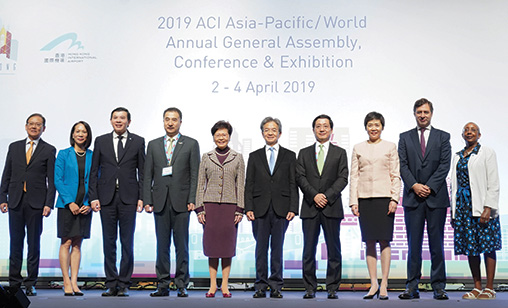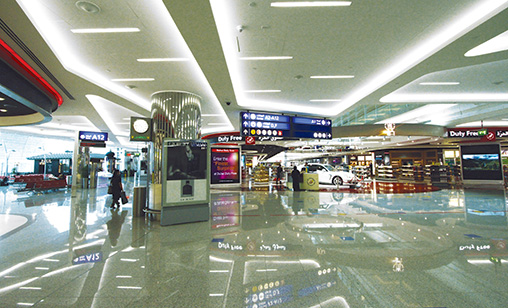Main Story
Airports plea for understanding on exploding infrastructure demands
Airport leaders gathered in Hong Kong last month for the World Annual General Assembly committed to closer co-operation with industry peers to hasten infrastructure expansion. Associate editor, Tom Ballantyne, reports from Hong Kong.
May 1st 2019
When Singapore Changi Airport CEO, Lee Seow Hiang, addressed delegates at Airports Council International’s (ACI) World Annual General Assembly (WAGA) in Hong Kong last month, he took pains to point out the Asia-Pacific contributed significantly to global GDP amounting to $2.7 trillion of economic impact. Read More »
“Our region has been a key driving force in contributing to world air traffic growth for the past decade. Emerging and developing economies will account for more than 60% of all passenger traffic and much of this growth will come from our region. In fact, of the ten fastest growing countries for passenger traffic from today to 2040, eight out of ten will be in the Asia-Pacific,” he said.
 |
But with growth comes tremendous challenges, he said. “Developing infrastructure to keep up with this demand will require substantial investment by all airports. In the Asia-Pacific and the Middle East alone, airports have planned to invest more than US$420 billion in new and existing airports, but it remains to be seen if this level of investment will accommodate the growth of aircraft fleet forecast by Airbus and Boeing,” said Lee, who also is ACI Asia-Pacific president.
It was a theme underscored by ACI director general, Angela Gittens, who said collaboration between all those involved is the key. At the assembly, delegates agreed unanimously to increase airport engagement with the International Civil Aviation Organization (ICAO) on capacity building, policy development and environmental protection.
As ICAO plans for its 40th Triennial Assembly from September 24 to October 4 this year, the ACI Assembly confirmed the importance of ACI alignment with the objectives of ICAO to advance a safe, secure, and sustainable air transportation system. In a resolution it recognized the value of working directly with regulators and policy makers to influence decisions at the ICAO level.
It also supported private investment in airports as one option for funding airport construction.
“We recognize at ACI there is no one formula for how we manage, fund or invest in our airports,” said Lee. “We believe that with sound regulatory measures privatization is a viable way to finance many of these infrastructure projects.”
He pointed to several projects underway in the region, including Navi Mumbai (India) and Western Sydney (Australia) and the major expansion of Hong Kong International Airport as examples of airports and governments responding to airline demand. Beijing’s second airport, Daixing, which will open in September, was built to handle 100 million passengers a year.
 |
| 'If we are to continue to keep pace with this demand airports must be able to invest, improve and grow. Charges for services rendered to airport users and non-aeronautical revenues are the major sources of funds for airports to invest in infrastructure and service improvements and efforts to irrationally restrict or regulate these things should be avoided' |
| Angela Gittens ACI director general |
Gittens said airports continue to serve economies as growth engines and critical contributors to global trade. “At the same time, airport operators face capacity constraints and, with our global medium-term forecast showing almost 30% growth in passenger numbers from 2017 to 2022, many national governments face the predicament of surging air transport demand that is outstripping available airport infrastructure,” she said.
“Generating a positive economic return depends on sound, strategic planning with appropriate financing mechanisms. There is no one size fits all approach and airports must take a long-term perspective to their business and ensure capacity improvements.”
Concerns about the pace of infrastructure development came as the latest monthly figures for January were released. They showed little let up in the pace of growth.
Passenger traffic across the Asia-Pacific rose 5.6% for the month, with China overtaking India in the top spot with an 8.1% increase in air passenger demand over the month a year ago.
Domestic and international sectors experienced strong growth, possibly enhanced by the China Lunar holiday cycle. The three airports with the biggest increases in passengers handled were Shanghai Pudong (+8.8%), Guangzhou (+8.6%) and Beijing (+5.8%).
In India, air passenger demand rose 6% over January a year ago but is trending downwards across both domestic and international networks. The bad news persisted on the freight front with air cargo in the Asia-Pacific declining 1.7% amid uncertain global economic conditions and the China/U.S tariff conflict.
In its preliminary report on world airport traffic rankings released in parallel with the Hong Kong conference, ACI said passenger traffic was estimated to reach 8.8 billion for the year, an uplift of 6% compared with 12 months ago.
This increase is above the 4.3% compound annual growth rate for passenger traffic from 2007 to 2017. Again, the air cargo market did not fare as well with a year-end growth figure of only 3.2%.
Reports highlights included:
* Beijing Airport surpassed the 100 million passenger mark in 2018, growing by 5.4% and holding onto second spot after the U.S’s Atlanta-Hartsfield-Jackson Airport (more than 107 million passengers) in the top ten global airport table.
* Hong Kong Airport remains the largest air cargo centre in the world, handling more than five million metric tonnes of cargo in 2018, a 1.4% increase over 2017.
* Shanghai Airport was third, with a decline in cargo volumes in 2018 of 1.5%. Shanghai grew by 11.2% in 2017 but this decline indicates demand has softened.
 |
“It is heartening to see global passenger traffic growth has remained resilient in the face of an increasingly tense and challenging geopolitical climate,” said Gittens. “However, the protectionist rhetoric that has swept through several Western countries will continue to restrain growth in the efficient flow of people, goods and services.”
In other significant findings, India became the world’s third largest domestic air passenger market in 2018, after the U.S. and China. India’s move towards a more liberalized aviation environment and the nation’s strengthening economic fundamentals contributed to its upgraded status.
Keynote speaker at the Hong Kong conference, ICAO secretary general, Dr Fang Liu, said: “Whether we’re focused on the increasing prevalence of drone operations or commercial space transport, ICAO has been grateful for the proactive inputs from ACI, governments and other air transport stakeholders as we seek to anticipate and close the gaps that might constrain future air transport growth and innovation.”
Remarking on the sector-wide trend of increasing digitalization, she said ICAO must constantly work to be ahead of industry change. As a standards-setting body it is beholden upon ICAO to anticipate and facilitate aviation innovations,” she said. “A key challenge this digital revolution poses for us is to find convergent global solutions which can practically apply to divergent local challenges and developments.”
She said the exponential growth forecasts for global fleets and passenger volumes and increased cybersecurity risks from aviation’s increasing reliance on digital automation, were examples of the necessity of rapid responses from the industry.
Dr. Liu said ICAO’s role was not to be overly prescriptive and therefore to restrict innovation, but to approach the challenges of a digitized air transport sector by establishing “a comprehensive sectoral architecture which will provide a secure core foundation for sustainable air transport digital interoperability”.
At the Hong Kong Assembly, hosted by Airport Authority Hong Kong, ACI released several key products and services to promote airport excellence. They included a Cybersecurity for Airport Executives Handbook that recommends critical actions that need to be taken at board level to address cybersecurity.
Other guides on offer are an Airport Business Continuity Handbook that lists best practices when airport operations are disrupted and the Addressing Insider Threat Handbook, which details a combined series of actions that form a robust multi-layered system in line with ACI’s risk-based approach to security.